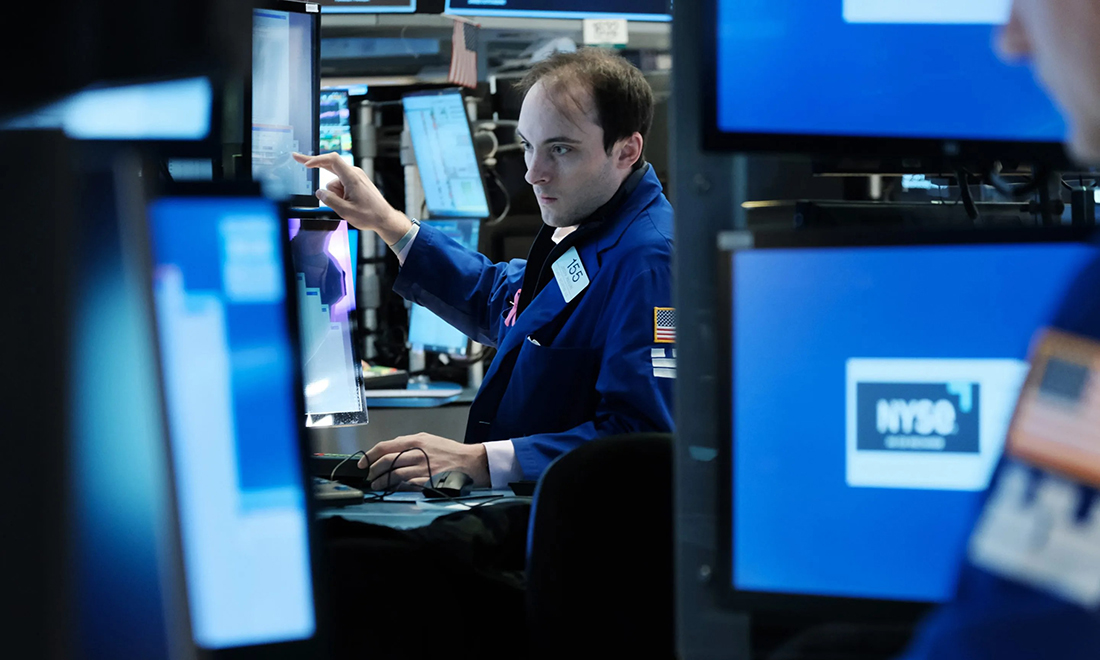明斯基时刻可能很快到来,投资者要做好出大事的准备

经济经历稳定和脆弱的阶段,然后一场危机就会突然爆发。这就是圣路易斯华盛顿大学(Washington University in St. Louis)的前经济学教授海曼·明斯基在1986年所警告的:那些承担了太多风险债务并允许投机性市场泡沫形成的经济体可能会面临这样的命运。几十年后,全球债务达到创纪录的300万亿美元,通货膨胀现象顽固,银行业发展不稳定,安联(Allianz)的首席经济学家卢多维克·苏布兰开始担心,明斯基的预言即将成真。
他在今年5月8日告诉彭博社(Bloomberg):“我们已经具备所谓明斯基时刻的所有要素。”
明斯基于1996年去世,享年77岁,他因其开创性的著作《稳定不稳定的经济》(Stabilizing an Unstable Economy)而闻名于世,该书认为经济周期有五个常见的阶段:正向冲击、乐观的繁荣、非理性疯狂、获利抛售及大恐慌。
在一个新的技术或模式,例如低利率或互联网使投资者兴奋之后,就会发生正向冲击。媒体的关注和口口相传就会造就与这个新现象相关的贷款和资产价格的繁荣,这反过来又吸引了更多害怕被抛弃的投资者,创造了一个兴奋和冒险的时期。但最终,随着资产价格与现实脱钩,债务人努力偿还贷款,一些投资者开始获利,非理性疯狂的情绪逐渐消失。这导致了明斯基时刻的到来,获利行为变成了大恐慌,资产价格开始暴跌。
明斯基认为,经济无法避免经历繁荣-萧条的周期,当金融家和投资者从贪婪的狂热转变为恐惧时,他们就会变成经济破坏者。我们已经两次看到他的理论成真,第一次是网络泡沫后科技股的快速抛售,然后是2008年全球金融危机期间房地产价格的崩溃。
安联的苏布兰于5月8日指出,另一个明斯基时刻可能到来的迹象是,随着银行收紧贷款标准,整个经济中的流动性逐渐消失。他警告说:“你到处都能看到这种情况。”他还指出,商业房地产是一个特别值得关注的领域,该行业正在与不断上升的空置率、崩溃的价格和对违约的担忧作斗争。这个行业受到了向混合型工作转变,以及利率上升和地区银行问题的影响,这些问题让获得新贷款或旧贷款的再融资几乎变得不可能。
苏布兰尤其担心持续的高利率可能导致银行业或来自非银行贷款人(比如对冲基金和养老基金)发生更多的“金融事故”,而这些非银行贷款人则专注于陷入困境的商业房地产领域。
“现在每个人面临的问题都是突然的紧缩,随后又多了一层错误的风险管理。”他指的是非银行贷款人的商业房地产贷款的潜在问题,这些贷款不受银行的相同法规约束。
苏布兰预计,今年的贷款条件和获得信贷的机会也将继续下降,他说这将最终引发美国的经济衰退。并且,这不会是2008年全球金融危机的“翻版”,但市场抛售将在未来几个月变得更加频繁。
苏布兰不是唯一担心明斯基时刻的人。摩根大通(JPMorgan Chase)的首席市场策略师和全球研究联席主管马尔科·科拉诺维奇在今年3月的一份说明中解释称,高通胀和利率上升增加了资产价格和贷款突然崩溃的可能性。
“市场和地缘政治出现明斯基时刻的可能性已经增加。”他写道,“即使中央银行家们成功地遏制了危机的蔓延,由于来自市场和监管机构的压力,信贷条件将会更快地进一步收紧。”(财富中文网)
译者:中慧言-项曦莹
经济经历稳定和脆弱的阶段,然后一场危机就会突然爆发。这就是圣路易斯华盛顿大学(Washington University in St. Louis)的前经济学教授海曼·明斯基在1986年所警告的:那些承担了太多风险债务并允许投机性市场泡沫形成的经济体可能会面临这样的命运。几十年后,全球债务达到创纪录的300万亿美元,通货膨胀现象顽固,银行业发展不稳定,安联(Allianz)的首席经济学家卢多维克·苏布兰开始担心,明斯基的预言即将成真。
他在今年5月8日告诉彭博社(Bloomberg):“我们已经具备所谓明斯基时刻的所有要素。”
明斯基于1996年去世,享年77岁,他因其开创性的著作《稳定不稳定的经济》(Stabilizing an Unstable Economy)而闻名于世,该书认为经济周期有五个常见的阶段:正向冲击、乐观的繁荣、非理性疯狂、获利抛售及大恐慌。
在一个新的技术或模式,例如低利率或互联网使投资者兴奋之后,就会发生正向冲击。媒体的关注和口口相传就会造就与这个新现象相关的贷款和资产价格的繁荣,这反过来又吸引了更多害怕被抛弃的投资者,创造了一个兴奋和冒险的时期。但最终,随着资产价格与现实脱钩,债务人努力偿还贷款,一些投资者开始获利,非理性疯狂的情绪逐渐消失。这导致了明斯基时刻的到来,获利行为变成了大恐慌,资产价格开始暴跌。
明斯基认为,经济无法避免经历繁荣-萧条的周期,当金融家和投资者从贪婪的狂热转变为恐惧时,他们就会变成经济破坏者。我们已经两次看到他的理论成真,第一次是网络泡沫后科技股的快速抛售,然后是2008年全球金融危机期间房地产价格的崩溃。
安联的苏布兰于5月8日指出,另一个明斯基时刻可能到来的迹象是,随着银行收紧贷款标准,整个经济中的流动性逐渐消失。他警告说:“你到处都能看到这种情况。”他还指出,商业房地产是一个特别值得关注的领域,该行业正在与不断上升的空置率、崩溃的价格和对违约的担忧作斗争。这个行业受到了向混合型工作转变,以及利率上升和地区银行问题的影响,这些问题让获得新贷款或旧贷款的再融资几乎变得不可能。
苏布兰尤其担心持续的高利率可能导致银行业或来自非银行贷款人(比如对冲基金和养老基金)发生更多的“金融事故”,而这些非银行贷款人则专注于陷入困境的商业房地产领域。
“现在每个人面临的问题都是突然的紧缩,随后又多了一层错误的风险管理。”他指的是非银行贷款人的商业房地产贷款的潜在问题,这些贷款不受银行的相同法规约束。
苏布兰预计,今年的贷款条件和获得信贷的机会也将继续下降,他说这将最终引发美国的经济衰退。并且,这不会是2008年全球金融危机的“翻版”,但市场抛售将在未来几个月变得更加频繁。
苏布兰不是唯一担心明斯基时刻的人。摩根大通(JPMorgan Chase)的首席市场策略师和全球研究联席主管马尔科·科拉诺维奇在今年3月的一份说明中解释称,高通胀和利率上升增加了资产价格和贷款突然崩溃的可能性。
“市场和地缘政治出现明斯基时刻的可能性已经增加。”他写道,“即使中央银行家们成功地遏制了危机的蔓延,由于来自市场和监管机构的压力,信贷条件将会更快地进一步收紧。”(财富中文网)
译者:中慧言-项曦莹
Stability, fragility, and then, suddenly, a crisis. That’s the fate that Hyman Minsky, a former economics professor at Washington University in St. Louis, warned in 1986 could be coming for economies that take on too much risky debt and allow speculative market bubbles to form. Decades later, with global debts touching a record $300 trillion and stocks rising in the face of stubborn inflation and banking instability, Allianz chief economist Ludovic Subran is worried Minsky’s prediction is about to come true.
“We have all the ingredients of a so-called Minsky moment,” he told Bloomberg on May 8.
Minsky, who passed away in 1996 at 77, is known for his seminal book, Stabilizing an Unstable Economy (1986), which argued that there are five common stages of an economic cycle: displacement, boom, euphoria, profit-taking, and panic.
Displacement happens after a new technology or paradigm, like low interest rates or the internet, excites investors. Media attention and word of mouth then creates a boom in loans and asset prices related to this new phenomenon, which in turn draws in even more investors who fear being left behind, creating a period of euphoria and risk-taking. But eventually, the euphoria fades as asset prices untether from reality, debtors struggle to pay back their loans, and some investors begin to take profits. That leads to a Minsky moment, with profit-taking turning to panic and asset prices plummeting.
Minsky argued that economies can’t avoid these boom-bust cycles, when financiers and investors transform into economic annihilators as their frenzy of greed shifts to fear. And since then, we’ve seen his theory come true twice, first in the rapid sell-off of tech stocks after the dot-com bubble and then again when real estate prices collapsed during the global financial crisis of 2008.
Allianz’s Subran noted on May 8 that one sign that another Minsky moment could be coming is the fading liquidity across the economy as banks tighten their lending standards. “You see that everywhere,” he warned, pointing to commercial real estate, which is struggling with rising vacancy rates, collapsing prices, and fears of defaults, as a particular area of concern. The sector has been affected by the shift to hybrid work, as well as rising interest rates and regional banks’ issues that have made getting new loans or refinancing old ones nearly impossible.
Subran is particularly worried that continued high interest rates could lead to more “financial accidents” in the banking sector or from non-bank lenders, like hedge and pension funds, that focus on the ailing commercial real estate sector.
“Everybody’s problem now is the very abrupt tightening, but then there is an additional layer of wrong risk management,” he said, referring to potential problems with non-bank lenders’ commercial real estate loans that aren’t subjected to the same regulations as banks’.
Subran expects lending conditions and access to credit to continue falling this year as well, which he says will eventually help spark a U.S. recession. This won’t be a “remake of the global financial crisis” of 2008, he said, but market sell-offs will become more frequent over the next few months.
Subran isn’t the only one worried about a Minsky moment either. JPMorgan Chase’s chief market strategist and global research co-head, Marko Kolanovic, explained in a March note that high inflation and rising interest rates have increased the odds of a sudden collapse in asset prices and lending.
“The possibility of a Minsky moment in markets and geopolitics has increased,” he wrote. “Even if central bankers successfully contain contagion, credit conditions look set to tighten more rapidly because of pressure from both markets and regulators.”













